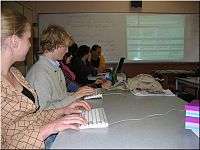Zing Technologies
| Developer(s) | Zing Technologies Pty Ltd |
|---|---|
| Stable release |
3.6
/ 2006 |
| Operating system | WinXP, Mac OS X |
| Type | groupware, team meeting and learning system |
| Website | http://www.anyzing.com/ |
Zing Technologies describes a proprietary collaborative software system for meeting and learning. There are two versions of the software, Anyzing and Zingthing. Both use a patented multi-cursor interface. The Zing team meeting and learning system depends on keyboard entry skills and lack of such skills can be a barrier to effective participation in the meeting or learning activity.
Introduction
A facilitator uses Zing to keep time and follow the agenda. A Zing facilitator often asks the group to follow a pre-determined meeting etiquette of four steps; Talk, Type, Read and Review. Participants are asked to first talk about the question or agenda item currently in focus on the screen. They do this as a group or split into pairs or groups of three. They are then invited to type their responses into the system. When everyone has finished typing, or the allotted time has expired, the group reads the responses and conclude the activity by reviewing what's been recorded, looking for key themes, common patterns or stand-out entries.
The system includes a range of tools for brainstorming, sorting and voting. The system is also used for learning activities. Thinking methods such as Edward De Bono's Six Thinking Hats have been used to structure Zing meetings. The number of participants in a group can vary from as few as four to as many as four hundred if people share keyboards or laptops and work in sub groups.
A number of independent academics are using Zing in their research for meetings, e-learning and gathering qualitative data.
- Alison Elliot, Australian Council for Educational Research
- Brian Caldwell, Professorial Fellow in the Department of Education Policy and Management of the University of Melbourne
- Jim Callan, a lecturer in marketing, Central Queensland University
- Robert Fitzgerald, Associate Dean Research, Faculty of Education at the University of Canberra
- Linda Newman, a senior lecturer of the School of Education of the University of Western Sydney
- Greg Whymark, an Associate Professor in Information Systems, Central Queensland University
Background
The software was first developed in Sydney, Australia, under the name Grouputer. A change in company ownership lead to a split and Grouputer Solutions and Zing Technologies went their separate ways. Zing software is now used in Australasia, Europe and North America. Zing software is designed to assist teams create new knowledge together and has been variously categorized as groupware, instructional technology, Group Decision Support Systems (GDSS), Decision Support Systems (DSS), electronic meeting systems and a Team Learning System.
Versions
- AnyZing requires a single computer, a data projector (or several monitors via a VGA splitter) and several keyboards which are connected to the computer via a USB hub or serial multiplexor. This version started life as Grouputer when the software was called Decisions. It had 3 components called Create, Meet and Learn. This has now become known as AnyZing, and the three components have given way to a more flexible multi-layered structure.
- ZingThing requires a server and client computers, one for the facilitator. Additional participants use extra keyboards attached to the client machines. Zingthing started life as WebGrouputer and its early development was undertaken by the CSIRO. This java based network enabled version requires a relatively fast internet or network connection. Zingthing's java implementation favours Windows and some features are missing in the Linux or Mac OS clients. The networking function of Zingthing means that a number of laptops can be linked using a Wireless LAN.
See also
External links
- Zing in schools

- A Dutch class at the Victorian School of Languages prepared students for their oral exams.
- Castle Hill High School, Australia
- La Fevre High School, South Australia
- Port Augusta Learning Community, Australia
- Central Queensland University, Australia
- Byfield State School, Australia
- Greensward College, UK
- Golden Flatts Primary School, UK
References
- Elliot, A., Findlay, J., Fitzgerald, R.N. & Forster, A. (2004). Transforming pedagogies using collaborative tools. World Conference on Educational Multimedia, Hypermedia and Telecommunications 2004(1), 2565-2569. ISBN 1-880094-53-3.
- Elliott, A. (2002). Scaffolding knowledge building strategies in teacher education settings. In Crawford, C., Willis, D., Carlsen, R., Gibson, I., McFerrin, K., Price, J., & Weber, R. (Eds.), Proceedings of Society for Information Technology and Teacher Education International Conference 2002 (pp. 827–829). Chesapeake, VA: AACE.
- Fitzgerald, R.N., & Findlay, J. (2004). A computer-based research tool for rapid knowledge-creation. Cantoni, L. and McLoughlin, C. (eds) World Conference on Educational Multimedia, Hypermedia and Telecommunications 2004(1), 1979-1984. ISBN 1-880094-53-3.
- Moyle, Kathryn. (2006). Focus groups in educational research: using ICT to assist in meaningful data collection. AARE Conference Paper Abstracts - 2006, ISSN 1324-9339
- Whymark, G., Callan, J., & Purnell, K. (2004, November 24). Online learning predicates teamwork: Collaboration underscores student engagement. Studies in Learning, Evaluation, Innovation and Development [Online], 1(2).
- Willcox, J & Zuber-Skerritt, O. (2003). Using the Zing team learning system (TLS) as an electronic method for the Nominal Group Technique (NGT). ALAR Journal, 8(1), 61-75.